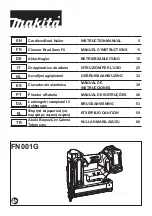
5 - ENG LISH
WARNING
Never connect the tool to an air source that is capable
of producing air pressure exceeding 200PSI.
Excessive
pressure can cause abnormal operation or cause the tool to
burst, resulting in personal injury.
WARNING
Do not exceed maximum recommended air pressure
marked on the tool.
Verify prior to using the tool that the
air source has been adjusted within the rated air-pressure
rang. Be sure the air pressure gauge is operating properly
and check it at least twice a day. Tools operated in excess of
their maximum pressure rating may operate abnormally or
burst resulting in personal injury.
To connect the tool to the compressor only use
pneumatic air hoses that meet the following criteria:
1. Minimum hose pressure rating, 200PSI.
2. Minimum hose inner diameter, 1/4 inch (6.4 mm).
3. Maximum hose length, 100 feet (30.5 meters).
FIG. 4
Connect the air supply:
• Snap the air hose onto the quick connector.
• Check for air leakage. If leakage is noted, cease using
the tool immediately and have the tool repaired by a
qualified service technician.
• Be sure the air pressure gauge is operating properly and
check it at least twice a day.
TOOL TESTING
DANGER
OPERATORS AND OTHERS IN WORK AREA MUST
WEAR SAFETY GLASSES WITH SIDE SHIELDS WHICH
CONFORMS TO ANSI Z87.1 SPECIFICATIONS.
WARNING
NEVER USE TOOL UNLESS SAFETY IS OPERATING
PROPERLY.
Before actually beginning the nailing work, test the tool by
using the check list below. Conduct the test in the following
order.
If abnormal operation occurs, stop using the tool immediately
and have the tool repaired by a qualified service technician.
1. Disconnect air hose from tool. Remove all nails from tool.
•
ALL SCREWS MUST BE TIGHTENED.
If any screws
are loose, tighten them.
•
THE SAFETY AND TRIGGER MUST MOVE
SMOOTHLY.
2. Adjust the air pressure to 70PSI, connect the air hose.
Do not load any nails in the tool.
•
THE TOOL MUST NOT LEAK AIR.
3. Remove the finger from the trigger and press the safety
against the wood.
•
THE TOOL MUST NOT OPERATE.
4. Separate the safety from the wood. Next, point the tool
downward, pull the trigger and then wait in that position
for 5 seconds or longer.
•
THE TOOL MUST NOT OPERATE.
5. a.
Without touching the trigger, depress the safety
against the workpiece. Pull the trigger.
•
THE TOOL MUST OPERATE
b. Hold the trigger back while separating the safety from
the wood.
The tool will remain in operated status (the driver
blade will remain at the bottom).
c. Remove the finger from the trigger.
Tool operation will end (the driver blade will return to
the top).
6. If no abnormal operation is observed, you may load nails
in the tool. Drive nails into the workpiece that is the same
type to be used in the actual application.
•
THE TOOL MUST OPERATE PROPERLY.
ADJUSTING THE OFFSET MAGAZINE
The load feature is designed for quick and easy reloads.
To avoid jamming, always adjust the magazine to the
correct position for the size nails you want to use. There
is an adjustment indicator inside the magazine to help you
choose the right position.
To adjust the magazine, pull up on the spool to the desired
position and then rotate it clockwise to set it. Rotate it
counterclockwise to lower that nail tray.
FIG. 5
Position Indicator
Spool


























